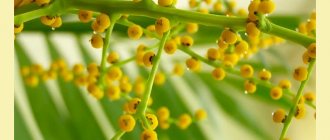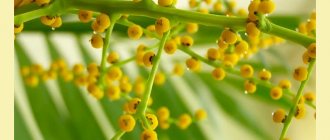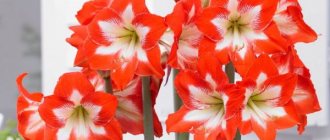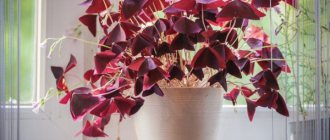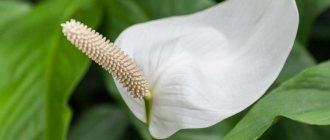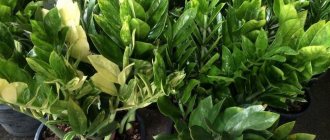If you have a Christmas star flower growing at home, then read the article. It tells you how to care for this plant and how to deal with pests.
On the eve of the New Year and Christmas , a flower boom begins: stores are full of cute pots with different miniature flowers. After all, this is a great holiday gift for lovers of home flowers.
Read an article on our website about why violets do not bloom at home. You will learn the reason and secrets that will help make the flower bloom.
Among the various plants on store windows, the Poinsettia flower, or as it is more often called the Christmas star . More details on how to care for this “miracle” are described in this article. Read on.
Red leaf flower Christmas star: history, legends
Flower "red leaf" Christmas star
The flower "red leaf" Christmas star comes from Mexico, where it grows in tropical thickets in the form of a green shrub that is always green. Its height is about 4 m . His story is very interesting:
- It became known as a potted plant about 100 years ago, thanks to the enterprising gardener Paul Ecke.
- He was the first to grow and sell this flower.
- Paul's work was continued by relatives, and now the American city of Encinitas produces approximately 80% of all poinsettias grown in the world.
- In terms of its profit, this business is approximately comparable to the income received from the sale of bulbs and flowers of Dutch tulips.
Red Leaf Flower Christmas Star
The exotic appearance of the plant has given rise to beautiful legends associated with its origin and cultivation:
- The people of Central America, whose ancestors were the Aztecs and where the plant is also widespread, believe that it was the favorite flower of their leader Montezuma.
- He worshiped his patroness, the goddess, who fell in love with a simple young man.
- But the goddess's heart was broken by this love, and drops of blood fell to the ground and turned into a bush. At its top, not green leaves began to grow, but blood red ones.
- When colonists and missionaries preaching Christianity appeared America Christmas by a girl from a very poor family.
- She bitterly regretted in her heart that, apart from the inconspicuous bouquet that she picked along the road, she had nothing else to bring to the temple for the holiday.
- With these thoughts, the girl lovingly laid her bouquet at the feet of the born Christ .
- After some time, the top of the plant turned bright red, and the whole plant suddenly became unusually beautiful. Since then, Catholic churches have been decorated with these flowers, which look like stars, on the day of the Nativity of Christ .
The flower owes its name to Joel Roberto Poinsetta . He was not only a diplomat, the first American ambassador to Mexico, but also an avid botanist. The young man collected herbariums and made descriptions of the plants of this country, growing in his flower garden the most curious specimens of the flora of Mexico found. The flower, now known throughout the world, was named after him.
What is the name of the Christmas star: Poinsettia flower
Red Leaf Flower Christmas Star
The Christmas Star plant is called Poinsettia . Such bright inflorescences have several other names:
- Latin - Euphorbia pulcherrima.
- Systematic - Beautiful spurge , from the genus Euphorbia , family Euphorbiaceae.
- Christmas star or Star of Bethlehem - the shrub received this name because the flowering period coincides with the Christmas holidays and, in addition, the bracts resemble a star.
- It is also called Holy Night Flower .
- In Chile it is called the Crown of the Andes , and in Spain the Easter Flower .
This is a very interesting flower that can bloom not only with red petals. Read on.
Poinsettia types and varieties, photos
Poinsettia, also known as beautiful euphorbia, has one single species and many varieties, differing in the color of the stipules - white, pale and bright pink, creamy white, blood red, one- and two-color.
The most popular varieties of poinsettia:
- Sonora White - ivory-colored bracts, very refined and noble.
- Strawberry and cream - pink-purple bract leaves with a white border.
- Winter Rose - the unusual shape of scarlet bracts makes the plant look like a rose.
- Jingle Bells - classic bright red bracts with white spots of various shapes.
- Premium Red, EuroGlory Black Beauty, Prestige Maroon, Champion - classic appearance.
- Polar Bear, Infinity White – delicate white bracts.
- Maren – soft pink bracts.
- Carousel Dark Red - very showy red bracts characterized by wavy edges.
- PeterStar Marble - soft pink bracts with a pure white edge.
- Ice Punch - The scarlet bracts are tinged with a soft pink along the midrib.
- Polly Pink – bright pink bracts.
- Monet Twilight - pink bracts with white speckles.
- Sonora White Glitter – bright red bracts with white spots and pointed leaf tips.
Home flower Christmas star - how it blooms: photo in autumn, what flowering colors are there?
Home flower Christmas star
What does poinsettia look like - home flower Christmas star ? The photos above and below show what beauty awaits you in autumn and winter if you plant such a plant at home.
Home flower Christmas star
The plant blooms so beautifully. Description:
- This is a small bush no more than 50 cm with dark green leaves with jagged edges and a small petiole.
- The leaf has an elongated ovoid shape, 10-15 cm in length.
- The main decoration is not the flowers, but the bracts, which have the same shape as the leaves, but are slightly smaller in size and very different in color.
- By the time the flowers bloom, they become bright scarlet.
Flower Christmas Star
Nowadays, varieties not only with red leaves have been bred. There is also a flower with foliage of a similar color:
- Pink
Home flower Christmas star
- White
Home flower Christmas star
- Lilac
Home flower Christmas star
- Burgundy
Home flower Christmas star
- Lilac
Home flower Christmas star
- Combining several shades
Home flower Christmas star
The flowers themselves fade into the background when compared with the brightest bracts. They are minimal in size, collected in flower rosettes, and have a nondescript shade of pale yellow.
Home flower Christmas star
General information about the plant
Poinsettia is a plant of the Euphorbiaceae family, named after Joel Poinsetti. He brought the flower to the USA for the first time and started breeding it. The overseas guest also has other names: the most beautiful euphorbia, the most beautiful euphorbia, the Christmas star.
Euphorbia is native to Central America, namely the tropical part of Mexico and Guatemala. Here, the Star of Bethlehem has the appearance of a two to three meter bush, which settles in the shade of the mountain slopes.
With sudden temperature changes, leaves fall off
Breeders managed to significantly reduce the size of the plant. In cultivation, it is a flower with a height of 30 to 50 cm, which is suitable for growing at home. It has straight stems, ovate, pointed leaves with denticles along the edges. At the tops there are small yellow rosette inflorescences framed by large bright perianths.
Flower Christmas star: choice in store
Flower Christmas Star
If you decide to give your friends or loved ones a gift in the form of a Christmas star the New Year , then at the point of sale you need to be careful and choose a suitable copy. The criteria for choosing a flower are:
- You should immediately pay attention to the poinsettia pots standing on shelves without packaging, and make a choice among them. Packaging can hide flaws and poor quality of the plant.
- The bush should be evenly developed on all sides , individual stems should not stick out and disturb the overall composition. Bare areas of branches should not be visible from under the leaves.
- The leaves are a rich dark green color. If there are wilted, drooping leaves with yellow spots or completely yellowed leaves, it means the plant is depressed and should not be purchased.
- The bracts are completely colored in the color characteristic of the variety. They should not have greenish spots, which indicates that the plant is underdeveloped.
- A careful inspection of the flowers is important - you can touch one of them with your finger. They should not have pollen on them. If it is still present, this indicates that the plant’s growing season will soon end and the bracts will fall off, the plant will very quickly lose its decorative appearance.
- Feel the soil in the pot. It should not be overly moist or, conversely, dry. Both indicate poor flower maintenance. if he ends up at home, he may simply die.
But now the purchase is made. By the way, do not buy a plant on the street, it will immediately wither at home, because... low temperatures will destroy it. Now you need to properly bring the plant home. At temperatures below 15°C, the poinsettia must be covered and in a box or wrapped in a packing paper sheet, otherwise transportation will have a very bad effect on it.
Christmas star flower: watering rules, how else to care for it at home so that it blooms?
Christmas Star Flower
the Christmas Star flower are simple:
- In summer you need to moisten the soil 2 times. in 7 days , in winter - 1 r. during the week .
- In any case, you need to focus on the condition of the soil in the pot - it should be slightly moist.
- It is forbidden to overfill the soil, because the roots can be affected by various rots.
- It is also dangerous to completely dry out the earthen clod; only light drying of the top layer of soil is allowed.
- The liquid for irrigation should only be used when it is warm and it is advisable that it sits for a day and night.
- It is also necessary to spray the flower with warm water, slightly moistening the air around it.
Read an article on our website about how to properly replant an indoor flower. Learn the tips of the professionals to ensure your flowers always look gorgeous.
How else to care for it at home so that it blooms? Here are the tips:
- For good flowering, it is important to provide the plant with sufficient lighting.
- But direct burning rays of the sun should not fall on the bush.
- Poinsettia also responds positively to temperature conditions, which during flowering should be no higher than 16°C .
Read on to learn what else you need to do to ensure beautiful flowering.
How to trim a Christmas star flower?
Flower Christmas Star
To make poinsettia bloom repeatedly, you need to prune the flowering bush. Flowering in this bush occurs only on young shoots. How to trim a Christmas star flower ?
- This process begins after the bush has bloomed and almost all the leaves have flown off.
- Before pruning, you need to dry the earthen ball well, but not until completely dry.
- Now on each stem, find the first bud from the ground. It will be located approximately in the place where the already fallen leaf grew. The bud is very small, but you can still notice it.
- Using sharp pruning shears, carefully cut the stem about 0.5 cm above this bud.
- Juice will immediately appear on the cut, so work must be done with gloves.
After pruning, water the soil in the pot.
Trimming
The purpose of pruning is to give the bush a beautiful shape and improve its health. It is usually carried out when the bract leaves begin to lose their color. Trim faded branches at a height of about 15 centimeters above ground level. Also, for the same purpose, young shoots that grow after transplantation are pruned.
Important! Pruning stimulates subsequent flowering of poinsettias.
Trimmed shoots can be used for propagation. The cuts themselves on the bush should be sprinkled with charcoal or activated carbon crushed to powder.
Indoor flower Christmas star: rules of propagation, transplantation
Indoor flower Christmas star
If necessary, poinsettia can be propagated. But this is not so easy to do. You need certain skills and experience working with this plant. Here are the transplant rules:
- The Christmas star indoor flower is propagated by cuttings that grow after pruning.
- They should be at least 9-10 cm , well developed and without signs of disease.
- You need to cut the cutting under the node that connects the cutting and the stem.
- Now place the cutting in a vase with warm liquid for a few minutes to allow the juice to come out.
- Prepare a pot in advance with loose soil soaked in special fertilizers.
- Treat the cut of the cutting with Kornevin or some other root growth stimulator.
- After making a hole, immerse the cutting about one-third into the soil. Pour it thoroughly.
Rooting will occur within 20-30 days.
How does the plant propagate: by seeds or cuttings?
Growing poinsettia from seeds is a rather lengthy and troublesome process. In addition, seedlings rarely retain the varietal characteristics of the mother plant. Therefore, this method is of interest mainly to professional breeders.
Reproduction by cuttings
The easiest way to propagate poinsettia is to root a cutting. There will be no problems with planting material, because every year the plant undergoes radical pruning. Flowering can be expected next winter - approximately 1.5 years after planting.
Cuttings are taken only from completely healthy poinsettias. The recommended length is 12–15 cm (there must be at least 5 internodes).
- Cut the cutting at a slight angle. The knife must be disinfected and sharpened.
- Blot the juice released from the cut with a soft napkin. If its flow does not stop, immerse the cutting in cool water for 10–15 minutes.
- Sprinkle the cut with sifted wood ash, powdered activated carbon, colloidal sulfur, and powder with Kornevin.
- Plant the cuttings in containers filled with a mixture of peat chips, humus, crushed manure and sand, perlite, vermiculite (1:1), moistening the substrate well.
- Cover the pots with glass jars or cut-off plastic bottles and place them in plastic bags. Open the “greenhouses” every day for 5–7 minutes to ventilate, and as the substrate dries, water it moderately with a weak solution of any root formation stimulator.
The following conditions will have a positive effect: a constant temperature of 25–28ºС, bright diffused light and lower heating.
Growing poinsettia from cuttings is a simple task that even a novice gardener can handle.
- Under optimal conditions, cuttings produce roots in 25–30 days. Transplant them into slightly larger containers with a substrate for adult plants and cut them back by about a quarter so that the poinsettia begins to “tush”. Further care is the same as for adult flowers.
Christmas star - flower after flowering: care rules
Christmas star - flower after flowering
Usually the Christmas star is presented as a New Year's . A few weeks will pass and the plant will shed its leaves, the stems will become bare and it seems as if it has died. But that's not true. Poinsettia is going into dormancy. If after flowering you provide it with proper care and maintenance, then the next year, in winter, it will bloom again and become decorative. What needs to be done for this? Here are the rules of care:
Christmas star - flower after blooming
- Reduce watering to a minimum; the soil in the pot should be almost dry, especially since there is no need to fertilize.
- Trim the stems so that they are no more than 15 cm from the soil level in the pot, as in the picture above.
- Place the bush in a cool and dark place where the temperature is within +13-14°C . Typically this location can be found under the bathroom or in a closet. If you have a cellar, you can place it on the lower rack, where the coolest place is. The flower will remain here until May.
- When spring comes, place the poinsettia pot on a sunny windowsill, but so that direct sunlight does not fall on the container and bush.
- Watering and feeding are resumed. Add liquid 2 r. in 7 days , but do not overfill the water, the soil should be slightly moist.
- Feed no more than 1 day. in 20 days complex min. fertilizer for flowers.
As soon as the growth of young buds and stems begins, do the following:
- Replant the poinsettia in fresh soil . To do this, choose a pot that is slightly larger than the old one. Soil can be bought at the store. It can be specialized - with a set of microelements necessary for the plant, or universal. In any case, you need a crumbly, breathable, neutral pH .
- Carefully remove the plant from the old pot.
- Remove the top and gently shake the soil from the lower roots.
- Then you need to place it in a new vessel with half-filled earth. At the same time, make sure that the roots do not bend or intertwine.
- Now carefully fill the pot to the top . You need to make sure that the root collar is at the same level as the old pot. All that remains is to spill the entire soil with warm liquid.
Poinsettia must increase its vegetative mass. Growth will continue until the end of October. Now create excellent conditions for it so that the bush blooms well. To achieve this, daylight hours are reduced to 10 hours . This can be done by covering the pot with a large box so that light does not penetrate inside. Continue to do this until the bracts begin to open. After this, proceed to normal care.
There is another interesting home flower - Dracaena Palm . Read about its care, it’s simple, and grow it at home. This plant is also called the tree of happiness.
When is the best time to propagate a plant? Is it possible immediately after purchase?
Reproduction is preferably carried out at the very beginning of summer . You should not touch the plant during the dormant period; it lasts almost 2 months, until the end of May.
After transplantation, the plant cannot be fed with anything for a month.
You should purchase a flower with closed buds, since the plant’s adaptation to a new place is long and difficult. The bush cannot be propagated for 1 month.
During the period of adaptation, the plant needs to create temperature conditions of +20 degrees ; it is strictly forbidden to allow drafts in the room.
The red flower Christmas star is withering in the house: what to do?
Red flower Christmas star withers in the house It is
always unpleasant when house plants die. It happens that the red Christmas star in the house withers. What to do? This can happen for various reasons:
- First, check the soil to see if it is waterlogged.
- Perhaps the plant does not have enough light - move it to the brightest part of the windowsill.
- If the ambient air temperature is less than 18°C , then this can also cause leaves to fall. Move the container with the bush to a warmer windowsill.
- Poinsettia does not tolerate sudden changes in temperature and air humidity very well, so there is no need to open a window for ventilation if there is a flower near it.
Dry air is also not the best option for growing such a plant. As mentioned above, it must be periodically irrigated with warm liquid, while not forgetting to humidify the surrounding air.
Transfer
Old plants are replanted between April and May; this can also be combined with formative pruning. If cuttings were carried out during the same period, then the rooted shoots are planted in containers in June-July.
Choose a pot a few centimeters larger than the previous one. However, the rule here is that the larger the container, the higher the poinsettia can grow. A layer of expanded clay drainage or broken brick must be poured onto the bottom. The old soil is shaken off the roots, but you should not clean it off using force - you can damage the root system.
After transplanting, place the pot in a warm room on a well-lit windowsill and begin to water it intensively, not forgetting to remove excess water from the pan. This is a sign for the plant that the growth period has begun.
Transplantation and care after purchase
Purchasing poinsettia is a kind of lottery - flowering plants are brought in in winter, after first filling the soil with plenty of water. At temperatures around zero, this becomes an impetus for the soil to freeze and the root system to rot. Therefore, it is best to choose a semi-dry, unblown plant, which may have stood in the store for several days beforehand.
Immediately after entering the apartment, the flower is placed on a lighted window, where the flowering period takes place. After 3-4 weeks, after the end of flowering and acclimatization, the plant is transplanted into a new, more spacious pot by transferring the coma .
Soil for a Christmas star
A slightly acidic substrate with a pH of 5.8-6.5 is preferred. The soil for planting poinsettias is mixed independently. To do this, take two parts of leaf soil, three parts of clay-turf soil and one part each of peat soil and sand. You can also add a little humus.
If it is not possible to prepare the soil yourself, then use a simple universal composition from the store with the addition of a small portion of sand.
Christmas star flower: diseases and pests
Christmas star flower: diseases and pests
Poinsettia, like many house plants, is susceptible to diseases. The Christmas star flower and pests can affect it.
- Leaf blades may develop powdery mildew . This occurs at low temperatures and constant and heavy watering. Just in case, for prevention, treat the leaves with phytosporin several times during the growing season.
- Gray rot and fusarium wilt constantly affects the plant. The preventive measures are the same.
- Overwatering the plant too often can cause various root rots. You can fight them with the same phytosporin or another biological product, for example, trichodermin.
There are also a lot of pests. The spider mite is especially dangerous - the enemy of all indoor flowers. It loves dry air, so moisten the space around the flower and the leaves themselves more often with a spray bottle. Thrips, scale insects and whiteflies can attack poinsettias while the green leaves are growing. They are destroyed using special insecticides, which are easy to purchase at any flower shop.
Brief description of care
- Bloom . This culture blooms on Christmas and New Year's Eve.
- Illumination . Bright but diffused light is required (windows facing east or west).
- Temperature . During active growth and development - from 18 to 25 degrees, during the flowering period - from 14 to 16 degrees, during dormancy - from 12 to 14 degrees.
- Watering . In the summer, the bushes are watered abundantly and systematically, and in the winter, the soil should be slightly moist.
- Air humidity . During the flowering period, the bushes need to be systematically moistened with lukewarm water from a sprayer.
- Fertilizer . Feed the plant in spring, summer and autumn 2 times a month with complex mineral fertilizer. When the bushes bloom, you will need a fertilizer containing a large amount of potassium.
- Trimming . Twice a year: in April the bush is shortened to 15 centimeters, and after replanting the plant is shaped.
- Rest period . In March or April for 6-7 weeks.
- Transplant . Regularly once a year at the end of the rest period.
- Reproduction . By cuttings.
- Pests . Thrips, mealybugs, whiteflies, scale insects, spider mites.
- Diseases . Gray rot, powdery mildew, fusarium.
Why the Christmas star flower does not turn red: reasons
The Christmas star flower does not turn red
. It happens that the leaves of this plant are always green. It is clear that this is not the norm. Why doesn't the Christmas star flower turn red? Here are the reasons:
- Poor plant care. Provide all the necessary growth conditions, and it will reward you with its colorful flowering.
- The most important factors are the temperature and humidity of the soil and air - this has already been mentioned above.
- Keeping daylight hours is also very important when growing.
Tip: Do not move the pot from place to place unless absolutely necessary. This causes severe stress to the plant, which also negatively affects it.
What to do to prevent various problems?
For prevention, you need to monitor the condition of the plant and the soil:
- inspect the roots during transplantation;
- observe the appearance of foliage and the regularity of flowering;
- Regularly fertilize the soil and monitor its moisture.
Attention. Problems arise from improper care: once it is normalized, the plant will return to its healthy state and appearance.
Red poinsettia is a real star, burning brightly in winter. It does not require floriculture skills: it is enough to create the necessary conditions once and sometimes carry out the appropriate manipulations (watering, fertilizing, pruning, replanting). For this alone the flower will be grateful and will be able to please the owner for several years.
Christmas star - signs: why do the leaves of a flower turn yellow and fall off?
Christmas star - the leaves turn yellow
The Christmas star is a magical and even enchanting flower. It can improve relationships between relatives and reconcile if they are in a quarrel, remove spells and improve health. It is believed that:
- Euphorbia can be placed near the newlyweds’ bed after the wedding celebration.
- This will speed up the birth of the baby, and the newlyweds will never experience infidelity.
- At other times, it is better to keep the bush in the living room or other room where no one sleeps.
Worth knowing: Poinsettia juice is saturated with poison, so place the container with the plant away from children and animals in the living area.
Here are the signs why the leaves of a flower turn yellow and fall off, although it should bloom vigorously:
- If the leaves suddenly turn yellow or fall off, this indicates the presence of damage or the evil eye in one of the household members.
- The Christmas star is usually a decoration for the New Year's holiday. It is believed that such a wildly blooming flower has the power of healing and brings success.
- Young couples who are unsuccessfully trying to conceive a baby should purchase a young bush. If it blooms, they will have a newborn.
- Sharp yellowing, falling leaves, wilting of inflorescences and red bracts indicate problems with the well-being of family members.
The plant tries to alleviate the sick person’s condition, expending a lot of energy, and may die. There are even more signs below. Read on.
Flower “Home Christmas Star” - signs for the home: impact on energy, health
Flower “Home Christmas Star”
Like any living creature, the flower “Home Christmas Star” subtly senses the atmosphere in the house where it lives. Here are the signs for the home and the impact on energy and health:
- A good, beautiful bush with elastic dark green leaves indicates that everything is fine in the house, the home energy is positively charged. Luck and prosperity will not leave this house.
- But, if suddenly the owners notice that not entirely positive changes are happening to the flower, although it receives everything it needs for normal growth, then something wrong has happened in the family. Quarrels, insults - all this negatively affects the flower. Try to find out if anyone at home is hiding their dissatisfaction or troubles at work.
- It is quite possible that someone in the family has health problems. Then the Christmas star will look depressed, trying to take on the negativity. She spends a lot of her vitality and may even die.
- The plant signals to the owners that someone is trying to bring damage or the evil eye to the house. This is indicated by a sharp change in the color of the leaves and their subsequent rapid falling.
As mentioned above, there were cases when the plant helped couples who, for some reason, could not have children. Such families gained prosperity, the husband got rid of jealousy once and for all, and the wife got the opportunity to give birth to a child.
The Christmas star flower is very beautiful. When he appears in the house, the energy and atmosphere in it immediately changes for the better. Therefore, if you don’t know what to give to your friends or family for the New Year holidays, then buy a poinsettia and surprise your family. Good luck!
